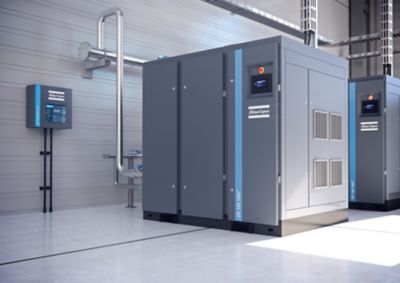The right compressed air components for your pneumatic conveying system
Whether it’s a blower or ancillary products like aftercoolers, dryers and filters, choosing the right compressed air components for your pneumatic conveying system can make the difference between a smooth, cost-efficient and sustainable operation and one that is expensive to run, causes you headaches and runs afoul with today’s or tomorrow’s environmental regulations.
Picking a correctly sized blower or compressor
It all starts with the blower or compressor. Dilute phase conveying is a low-pressure application that only requires an air pressure of 2.5 bar or less. For dense-phase conveying, on the other hand, you need a higher pressure. In some cases, this demand can be met by a low-pressure compressor.
This is where many operations make their first mistake because they waste a lot of money by oversizing their compressor. Purchasing a compressor or blower that is larger than it has to be not only needlessly increases your initial investment costs but also results in a higher energy consumption afterward. That is why it is also worth it for companies to replace oversized compressors or blowers they have already purchased with a more suitable model. In either case, whether it is the investment in a new blower or the replacement of an existing one, “going big” can be a costly miscalculation because energy expenses make up the bulk of the total cost of ownership over a compressor or blower’s service life.
It is an error that not only hurts the bottom line but also impacts the environment since increased energy consumption also means more emissions. To ensure that you make the optimal choice, we offer a wide range of compressors and blowers of all sizes for your pneumatic conveying application. And, before you select the type of compressor you want, you can request a sizing to make sure that it is the optimal size.
These include oil-free lobe blowers, oil-free screw blowers and oil-free claw blowers.
In addition, our portfolio includes oil-free screw compressors and oil-injected screw compressors.
Why so many types? To provide you with the best possible compressor or blower for your application and business. Each technology has its own benefits in terms of size and cost. Matching the right compressed air solution to your process means fewer blockages, shorter unloading times and finding the right balance between investment and lifecycle cost. That is why, if you are unsure about the proper size or type of blowers or compressors, our experts are always ready to assist you. A free sizing check of your installation will help you to make the right decision and show you your potential savings.
Not only does that guarantee that you pick the right type of compressor or blower and do not overspend on a model that is too large, it also help you meet your sustainability goals.
Choosing the right ancillary components for your system
The sum is bigger than its parts. By getting all of your equipment from a single source, you never suffer from any compatibility or installation issues because all of our products are designed to work together in the most efficient way.
Aftercoolers play a crucial role in protecting your system by keeping the air temperature below a specific limit. This is especially important when conveying products that could be burned, such as sugar, or combust, such as grains. In addition, you may also be subject to local and national safety standards for high explosion risk areas or processes. To avoid combustion, the compressed air must be kept below a certain temperature. While some of our compressors have integrated aftercoolers, blowers generally do not, which means one must be installed separately. There are air-cooled and water-cooled aftercoolers. Keep in mind that, if you choose a water-cooled model, you may also have to add a chiller, which lowers the temperature of the cooling water to a manageable and consistent level.
Next up are water separators or dryers. A byproduct of using aftercoolers is moisture that can diminish the quality of your products. A water separator will remove it before it can harm the goods you are conveying. Most integrated aftercoolers come with a water separator. Dryers can also get rid of moisture but are seldomly used in this process.
Finally, there are different methods of dealing with contaminants in your compressed air. The use of oil-free equipment is essential in certain industries, such as the food and pharmaceutical sectors.

